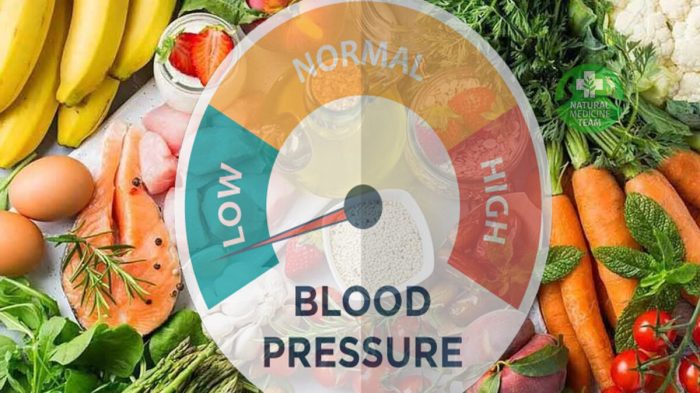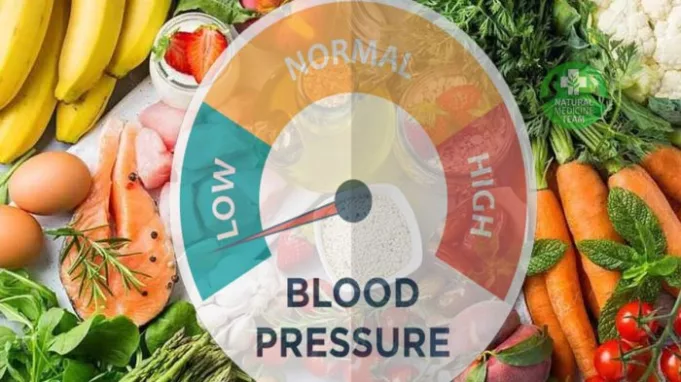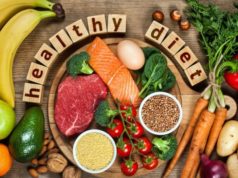What is good diet for high blood pressure – What is a good diet for high blood pressure? This question is a crucial one for millions of people worldwide who grapple with this common health concern. High blood pressure, often referred to as the “silent killer,” can lead to serious complications if left unchecked. Understanding the relationship between diet and blood pressure is essential for managing this condition and improving overall health.
The DASH diet, or Dietary Approaches to Stop Hypertension, is a cornerstone of a healthy lifestyle for individuals with high blood pressure. This diet emphasizes fruits, vegetables, whole grains, and low-fat dairy products, while limiting sodium, saturated fat, and cholesterol. By incorporating these principles, individuals can effectively lower their blood pressure and reduce their risk of heart disease, stroke, and other cardiovascular problems.
Understanding High Blood Pressure
High blood pressure, also known as hypertension, is a common condition that affects millions of people worldwide. It is characterized by persistently elevated blood pressure readings, which can put a strain on your heart and blood vessels. Understanding the causes, risk factors, and potential complications of high blood pressure is crucial for maintaining your overall health.
Causes and Risk Factors
High blood pressure can be caused by a variety of factors, including genetics, lifestyle choices, and underlying medical conditions. While some individuals may have a predisposition to high blood pressure due to family history, certain lifestyle factors can significantly contribute to its development. These include:
- Unhealthy Diet: A diet high in sodium, saturated fats, and cholesterol can raise blood pressure.
- Lack of Physical Activity: Regular exercise helps to lower blood pressure by strengthening the heart and improving blood flow.
- Obesity: Excess weight puts additional strain on the heart and blood vessels, increasing the risk of high blood pressure.
- Smoking: Nicotine constricts blood vessels, raising blood pressure and increasing the risk of heart disease.
- Excessive Alcohol Consumption: Excessive alcohol intake can damage the heart and blood vessels, leading to high blood pressure.
- Stress: Chronic stress can contribute to high blood pressure by triggering the release of hormones that constrict blood vessels.
- Certain Medical Conditions: Conditions like kidney disease, diabetes, and thyroid disorders can also lead to high blood pressure.
Potential Complications
Uncontrolled high blood pressure can have serious consequences for your health, potentially leading to:
- Heart Disease: High blood pressure puts extra strain on the heart, increasing the risk of heart attacks, strokes, and heart failure.
- Stroke: High blood pressure can damage blood vessels in the brain, increasing the risk of stroke.
- Kidney Disease: High blood pressure can damage the blood vessels in the kidneys, leading to kidney failure.
- Eye Damage: High blood pressure can damage the blood vessels in the eyes, leading to vision loss.
- Aneurysm: High blood pressure can weaken blood vessel walls, increasing the risk of aneurysms, which are bulges in the blood vessels.
How High Blood Pressure Affects the Body
High blood pressure exerts pressure on the walls of arteries, the blood vessels that carry oxygenated blood from the heart to the rest of the body. This constant pressure can damage the arteries, making them less flexible and more prone to blockages. Over time, this damage can lead to various health problems, including:
- Heart Strain: The heart has to work harder to pump blood through narrowed arteries, increasing the risk of heart disease.
- Blood Vessel Damage: High blood pressure can damage the lining of blood vessels, making them more prone to blockages and aneurysms.
- Organ Damage: High blood pressure can damage vital organs, such as the brain, kidneys, and eyes.
The DASH Diet

The DASH (Dietary Approaches to Stop Hypertension) diet is a well-researched eating plan specifically designed to lower blood pressure. It emphasizes fruits, vegetables, and whole grains while limiting saturated and unhealthy fats, cholesterol, and sodium.
Key Principles and Guidelines
The DASH diet focuses on a balanced approach to eating, emphasizing nutrient-rich foods and limiting those high in sodium, saturated fat, and cholesterol.
- Fruits and Vegetables: Consume 4-5 servings of fruits and 4-5 servings of vegetables daily. These provide essential vitamins, minerals, and fiber, which are beneficial for overall health and blood pressure management.
- Whole Grains: Choose whole grains over refined grains whenever possible. Whole grains provide more fiber, which helps regulate blood pressure.
- Lean Protein: Select lean protein sources like poultry without skin, fish, beans, and lentils. These are lower in saturated fat and cholesterol, promoting heart health.
- Low-Fat Dairy: Include low-fat dairy products like milk, yogurt, and cheese in your diet. These provide calcium, which is essential for bone health and may play a role in blood pressure regulation.
- Healthy Fats: Focus on healthy fats like those found in olive oil, avocados, nuts, and seeds. These fats can help lower LDL cholesterol (the “bad” cholesterol) and improve heart health.
- Limit Sodium: Reduce your daily sodium intake to less than 2,300 milligrams, aiming for 1,500 milligrams or less. Excessive sodium intake can raise blood pressure.
- Limit Saturated and Trans Fats: Reduce your intake of saturated and trans fats, which are found in red meat, full-fat dairy products, and processed foods. These fats can raise LDL cholesterol and increase the risk of heart disease.
- Limit Added Sugars: Reduce your intake of added sugars, which are found in sugary drinks, desserts, and processed foods. Excessive sugar intake can contribute to weight gain and other health problems.
Recommended Food Servings
The following table provides a sample meal plan for the DASH diet, outlining the recommended servings for each food group:
| Food Group | Servings per Day | Examples |
|---|---|---|
| Fruits | 4-5 | Apples, bananas, oranges, berries, grapes |
| Vegetables | 4-5 | Broccoli, carrots, spinach, tomatoes, cucumbers |
| Grains | 6-8 | Whole-wheat bread, brown rice, oatmeal, quinoa |
| Lean Protein | 2-3 | Chicken breast, fish, beans, lentils, tofu |
| Low-Fat Dairy | 2-3 | Skim milk, low-fat yogurt, low-fat cheese |
| Fats | 2-3 | Olive oil, avocados, nuts, seeds |
Scientific Evidence
Numerous studies have demonstrated the effectiveness of the DASH diet in lowering blood pressure.
“The DASH diet has been shown to reduce systolic blood pressure by 8-14 mmHg and diastolic blood pressure by 3-6 mmHg in individuals with prehypertension or stage 1 hypertension.” – National Heart, Lung, and Blood Institute
The DASH diet’s effectiveness is attributed to its focus on reducing sodium intake, increasing potassium intake, and promoting a balanced intake of other nutrients. The diet’s emphasis on fruits, vegetables, and whole grains provides a rich source of potassium, magnesium, and fiber, which have been shown to play a role in blood pressure regulation.
Dietary Recommendations
Now that you understand the basics of high blood pressure and the DASH diet, let’s dive into specific dietary recommendations that can help you manage your condition.
Sodium Intake
Sodium plays a crucial role in regulating blood pressure. When you consume too much sodium, your body retains water, increasing the volume of blood circulating in your system. This increased volume puts more pressure on your arteries, leading to high blood pressure.
A diet rich in fruits, vegetables, and whole grains is crucial for managing high blood pressure. This type of diet often emphasizes reducing sodium intake and incorporating foods rich in potassium, magnesium, and calcium. You might be wondering how the Golo diet, which focuses on managing blood sugar levels, fits into this picture.
Learn more about how does golo diet work and see if it could be a suitable approach for you. Ultimately, a healthy diet for high blood pressure is tailored to individual needs and should be discussed with a healthcare professional.
The American Heart Association recommends limiting sodium intake to less than 2,300 milligrams per day, with an ideal target of 1,500 milligrams for most adults. This is especially important for people with high blood pressure.
Potassium-Rich Foods
Potassium works in opposition to sodium, helping to relax blood vessels and lower blood pressure. Increasing your potassium intake can help counterbalance the effects of sodium. Here are some foods that are excellent sources of potassium:
- Bananas: A single medium banana provides about 422 milligrams of potassium.
- Sweet potatoes: One medium sweet potato provides about 542 milligrams of potassium.
- Avocados: A half of an avocado contains about 487 milligrams of potassium.
- Black beans: A cup of cooked black beans provides about 706 milligrams of potassium.
- Salmon: A 3-ounce serving of cooked salmon provides about 490 milligrams of potassium.
Sample Meal Plan
Here’s a sample meal plan that incorporates DASH diet principles and low-sodium options:
| Meal | Food | Sodium (mg) | Potassium (mg) |
|---|---|---|---|
| Breakfast | 1 cup oatmeal with 1/2 cup berries and 1/4 cup chopped walnuts | 150 | 400 |
| Lunch | 2 cups salad with grilled chicken breast, 1/4 cup chickpeas, and a light vinaigrette dressing | 200 | 500 |
| Dinner | 4 ounces baked salmon with 1 cup steamed broccoli and 1/2 cup brown rice | 100 | 600 |
| Snack | 1 medium banana | 10 | 422 |
This meal plan provides a balanced intake of fruits, vegetables, whole grains, and lean protein, while keeping sodium intake low and potassium intake high. Remember to read food labels carefully and choose low-sodium options whenever possible.
A diet rich in fruits, vegetables, and whole grains is generally recommended for managing high blood pressure. It’s important to limit processed foods, saturated fats, and added sugars. You might be wondering if diet soda fits into a healthy diet, especially if you’re following a ketogenic diet.
To learn more about whether diet soda is keto-friendly, check out this article: is diet soda keto. Ultimately, a balanced diet that includes plenty of fresh, unprocessed foods is key to managing high blood pressure.
Lifestyle Modifications
Making lifestyle changes can be just as crucial as dietary modifications when it comes to managing high blood pressure. Regular physical activity, stress management, and quitting smoking are essential components of a holistic approach to lowering and controlling blood pressure.
Regular Physical Activity
Engaging in regular physical activity is a cornerstone of managing high blood pressure. It helps lower blood pressure by strengthening the heart and improving blood circulation. Aim for at least 30 minutes of moderate-intensity exercise most days of the week. Examples include brisk walking, cycling, swimming, or dancing.
A good diet for high blood pressure focuses on reducing sodium intake and incorporating foods rich in potassium, magnesium, and fiber. If you’re looking for a comprehensive approach to lowering your blood pressure, the best diet to lower blood pressure combines these elements with other dietary strategies.
This type of diet emphasizes fresh fruits and vegetables, whole grains, lean proteins, and healthy fats, while limiting processed foods, sugary drinks, and saturated fats. By following a balanced diet, you can effectively manage your blood pressure and improve your overall health.
Stress Management
Chronic stress can significantly contribute to high blood pressure. Finding healthy ways to manage stress is essential for maintaining cardiovascular health. Techniques such as deep breathing exercises, meditation, yoga, and spending time in nature can help reduce stress levels and lower blood pressure.
Quitting Smoking
Smoking is a major risk factor for high blood pressure and heart disease. Nicotine constricts blood vessels, increasing blood pressure and putting extra strain on the heart. Quitting smoking can significantly reduce your risk of developing high blood pressure and other cardiovascular problems.
Consult a Healthcare Professional
It is crucial to remember that managing high blood pressure effectively requires a collaborative approach involving you and your healthcare provider. Regular monitoring and follow-up with a doctor are essential to ensure your blood pressure remains within a healthy range.
Importance of Regular Monitoring and Follow-up
Regular blood pressure monitoring is vital for tracking your progress and identifying any potential fluctuations. This allows your doctor to adjust your treatment plan as needed, ensuring optimal blood pressure control. It is recommended to have your blood pressure checked at least once a year, or more frequently if you have been diagnosed with high blood pressure.
Role of Medication in Managing High Blood Pressure
In many cases, medication plays a significant role in managing high blood pressure. Your doctor will prescribe the appropriate medication based on your individual needs and medical history. These medications help to lower your blood pressure by relaxing blood vessels, reducing the force of your heartbeat, or both.
Potential Interactions Between Dietary Choices and Prescribed Medications, What is good diet for high blood pressure
It is important to be aware of potential interactions between dietary choices and prescribed medications. Some foods and supplements can interfere with the effectiveness of certain blood pressure medications. For example, grapefruit juice can interact with certain calcium channel blockers, potentially increasing their concentration in the body and leading to adverse effects.
It is essential to discuss any dietary changes with your doctor before making significant adjustments to your diet, especially if you are taking medication for high blood pressure.
Wrap-Up: What Is Good Diet For High Blood Pressure
In conclusion, adopting a healthy diet is a critical component of managing high blood pressure. By embracing the DASH diet principles, focusing on nutrient-rich foods, and limiting processed foods, individuals can take control of their blood pressure and improve their overall health. Remember, consulting a healthcare professional is essential for personalized guidance and monitoring, ensuring a tailored approach to managing this condition effectively.
Detailed FAQs
What are the signs and symptoms of high blood pressure?
High blood pressure often has no noticeable symptoms, which is why it’s called the “silent killer.” Regular blood pressure checks are essential for early detection. However, some individuals may experience headaches, dizziness, nosebleeds, or shortness of breath.
Can I lower my blood pressure with diet alone?
While a healthy diet plays a crucial role in managing high blood pressure, it may not always be sufficient on its own. In many cases, medication is necessary to achieve and maintain optimal blood pressure levels. Consulting a doctor is essential to determine the best course of action.
Are there specific foods I should avoid completely when I have high blood pressure?
While limiting sodium, saturated fat, and added sugar is essential, there’s no need to completely eliminate any particular food group. Focus on making healthy choices within each food group and prioritize nutrient-rich options.
What are some quick and easy tips for incorporating the DASH diet into my daily life?
Start by gradually incorporating more fruits and vegetables into your meals. Choose whole grains over refined grains. Opt for lean protein sources like fish, poultry, and beans. Limit processed foods, sugary drinks, and saturated fats. Make small changes over time to build sustainable healthy habits.
























